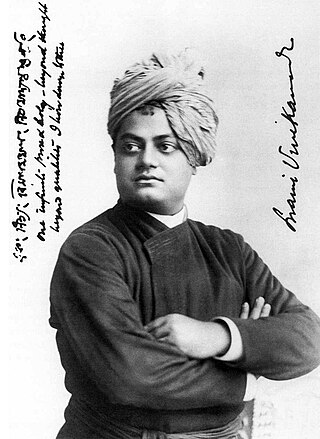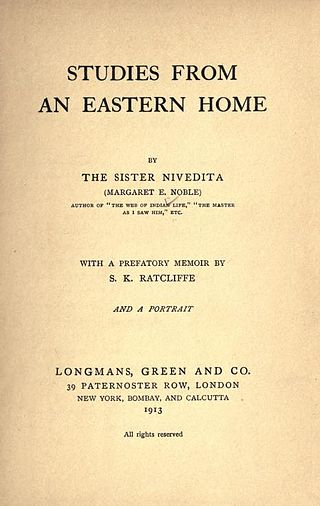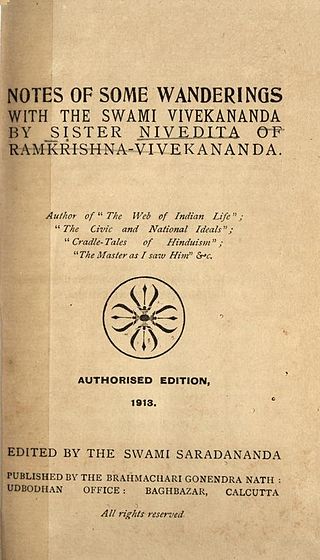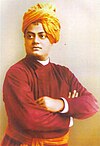
Swami Vivekananda, born Narendranath Datta was an Indian Hindu monk, philosopher, author, religious teacher, and the chief disciple of the Indian mystic Ramakrishna. He was a key figure in the introduction of Vedanta and Yoga to the Western world. He is credited with raising interfaith awareness and bringing Hinduism to the status of a major world religion in the late nineteenth century.

Ramakrishna, also called Ramakrishna Paramahansa, born RamakrishnaChattopadhay, was an Indian Hindu mystic. He was a devotee of the goddess Kali, but adhered to various religious practices from the Hindu traditions of Vaishnavism, Tantric Shaktism, and Advaita Vedanta, as well as Christianity and Islam. He advocated the essential unity of religions and proclaimed that world religions are "so many paths to reach one and the same goal". His parable-based teachings espoused the ultimate unity of diverse religions as being means to enable the realization of the same God. He is regarded by his followers as an avatar.

Sister Nivedita was an Irish teacher, author, social activist, school founder and disciple of Swami Vivekananda. She spent her childhood and early youth in Ireland. She was engaged to marry a Welsh youth, but he died soon after their engagement.

Prabuddha Bharata Or Awakened India is an English-language monthly journal of the Ramakrishna Order, in publication since July 1896. It carries articles and translations by monks, scholars, and other writers on humanities and social sciences including religious, psychological, historical, and cultural themes. It has a section of book reviews where important publications from university presses from around the world are reviewed. It is edited from Advaita Ashrama, Mayavati, Uttarakhand, and published and printed in Kolkata. Prabuddha Bharata is India's longest running English journal.
Ramakrishna (1836–1886) was a 19th-century Indian mystic whose teachings form the foundation of the Ramakrishna religious movement, Ramakrishna Order and Ramakrishna Mission.
Ramakrishna (1836–1886) is a famous mystic of nineteenth-century India. Ramakrishna never wrote down the details of his own life. Sources for his life and teachings come from the writings of his disciples and live witnesses. Ramakrishna's recorded sayings mainly come from the last four years of his life.

Amiya Prosad Sen is a historian with an interest in the intellectual and cultural history of modern India. Currently he is Sivadasani Fellow at the Oxford Centre for Hindu Studies, Oxford (UK). He was previously the Heinrich Zimmer Chair at the South Asia Institute, Heidelberg University. He has served as Professor of Modern Indian History at Jamia Millia Islamia, New Delhi. He has been Agatha Harrison Fellow to the University of Oxford and Visiting Fellow to the Indian Institute of Advanced Study, Shimla, and the Centre for Contemporary Studies, Nehru Memorial Museum & Library, New Delhi. During 2007–08, he was Tagore professor at Vishwa Bharati, Shantiniketan.
Pavhari Baba (1798–1898) was a Hindu ascetic and saint. He was born in Premapur, Jaunpur in a Brahmin family. In his childhood he went to Ghazipur to study under the tutelage of his uncle who was a follower of Ramanuja or Shri sect. After finishing his studies he travelled to many places. At Girnar in Kathiawar he was initiated into Yoga.

Josephine MacLeod was an American friend and devotee of Swami Vivekananda. She had a strong attachment to India and was an active participant in the Ramakrishna Vivekananda movement. She was given the nicknames "Tantine" and "Jo Jo" by Vivekananda. She considered Swami Vivekananda to be her friend and helped him with his finances. MacLeod was not a sanyasin, unlike many others such as Sister Nivedita or Sister Christine. She was instrumental in spreading Vivekananda's message on Vedanta in the West. She made many contributions to the initial and the later phases of the development of the order of Ramakrishna and Vivekananda. She was a contributor to many causes espoused by Sister Nivedita, the most famous disciple of Vivekananda, including that of contributing financially towards the development of the Indian National Movement especially in Bengal and elsewhere in India.

Cradle Tales of Hinduism (1907) is a collection of stories by Sister Nivedita. It is an introduction to Hindu mythology; the stories come from the Mahabharata, the Ramayana and other Hindu sources and are presented as they were told in Indian nurseries.

An Indian Study of Love and Death (1908) is a book written by Sister Nivedita.

Myths of the Hindus & Buddhists (1913) is a book written by Sister Nivedita and Ananda K. Coomaraswamy.

Studies from an Eastern Home (1913) is an autobiographical book written by Sister Nivedita.

Notes of Some Wanderings with the Swami Vivekananda (1913) is an English-language book written by Sister Nivedita. In this book Nivedita has narrated the experiences she had while traveling with Swami Vivekananda in different parts of India.

Swami Vivekananda (1863–1902) was an Indian Hindu monk and a key figure in the introduction of Indian philosophies of Vedanta and Yoga to the western world. He was one of the most influential philosophers and social reformers in his contemporary India and the most successful and influential missionaries of Vedanta to the Western world. Indian Nobel laureate poet Rabindranath Tagore's suggested to study the works of Vivekananda to understand India. He also told, in Vivekananda there was nothing negative, but everything positive.

My Master is an English book combined from two lectures delivered by Swami Vivekananda in New York and England, published in 1901.

Sister Christine or Christina Greenstidel was a school teacher, and close friend and disciple of Swami Vivekananda. On 24 February 1894, Christine attended a lecture of Vivekananda in Detroit, United States which inspired her. She started communicating with Vivekananda through letters. Christine went to India in 1902 and began working as a school teacher and a social worker.

Swami Vivekananda, the nineteenth-century Indian Hindu monk, is considered one of the most influential people of modern India and Hinduism. Rabindranath Tagore suggested to study Vivekananda's works to learn about India. Indian independence activist Subhas Chandra Bose regarded Vivekananda as his spiritual teacher. Mahatma Gandhi said that after reading the works of Vivekananda, his love for his nation became a thousand-fold.

Swami Sadananda, born Sharat Chandra Gupta, popularly known as Gupta Maharaj in the Ramakrishna Order, was a direct monastic disciple of Swami Vivekananda. He was the first disciple according to some sources. He took his monastic vows and joined Baranagar Math to serve the other disciples of Sri Ramakrishna in 1888–89 and subsequently joined the Belur Math when it was established. He was one of the leaders of early Ramakrishna Mission in its relief work. One of his significant contributions was providing relief to the citizens of Calcutta during the plague epidemic of 1898–99. He traveled to Japan in 1903. His later days were spent in company of Sister Nivedita as her protector and guide. His notable contribution in the later part of his life was preaching the message of Swami Vivekananda, especially among youth.
In 1888, Swami Vivekananda left the monastery as a Parivrâjaka— the Hindu religious life of a wandering monk, "without fixed abode, without ties, independent and strangers wherever they go". His sole possessions were a kamandalu, staff and his two favourite books: the Bhagavad Gita and The Imitation of Christ. Narendra travelled extensively in India for five years, visiting centres of learning and acquainting himself with diverse religious traditions and social patterns. He developed sympathy for the suffering and poverty of the people, and resolved to uplift the nation. Living primarily on bhiksha (alms), Swami Vivekananda travelled on foot and by railway. During his travels he met, and stayed with Indians from all religions and walks of life: scholars, dewans, rajas, Hindus, Muslims, Christians, paraiyars and government officials.


















